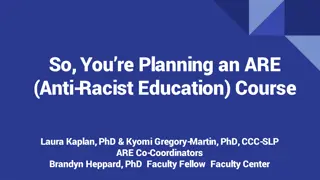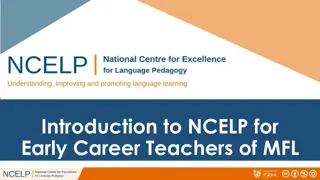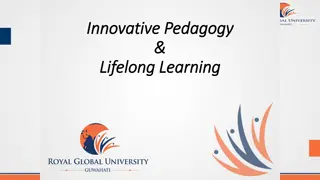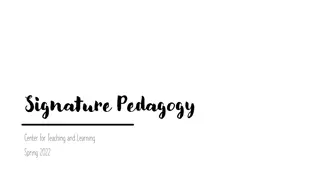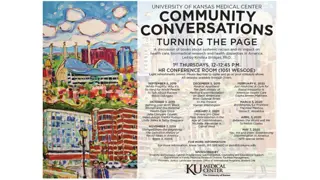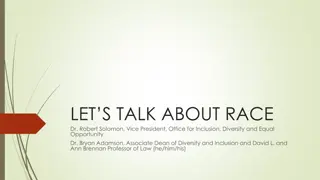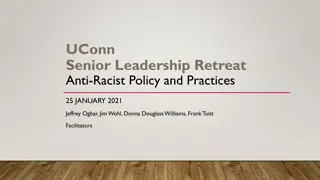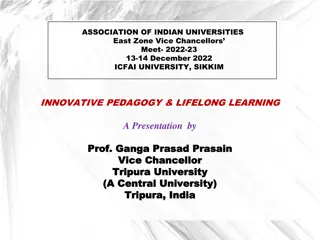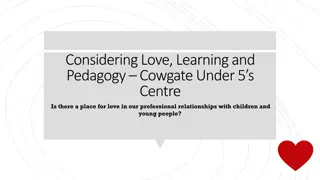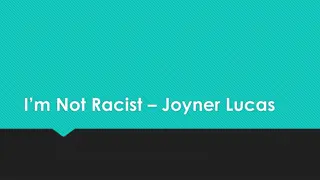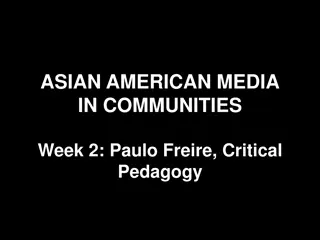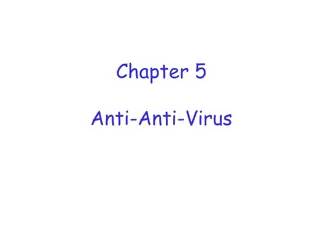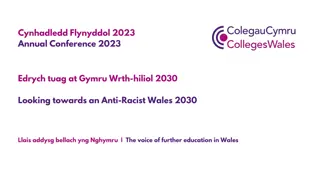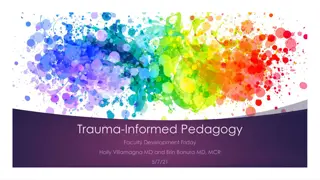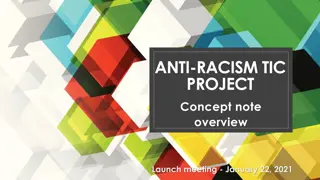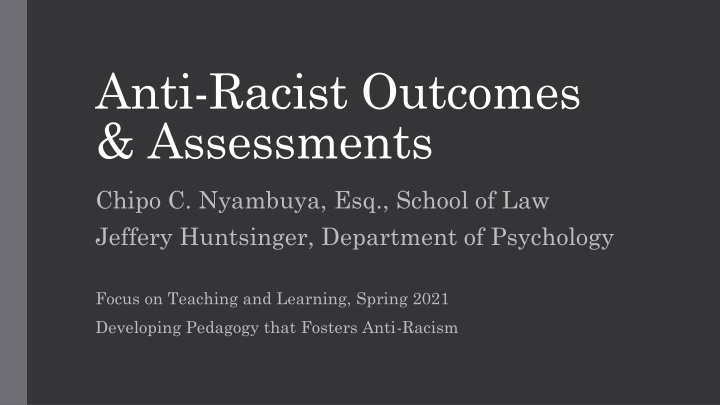
Developing Pedagogy for Anti-Racist Education
Focusing on pedagogy that fosters anti-racism in educational settings. Exploring strategies for creating inclusive learning outcomes, addressing biases, and setting meaningful goals. Emphasizing self-reflection, evolving past shortcomings, and engaging with diverse perspectives.
Uploaded on | 0 Views
Download Presentation

Please find below an Image/Link to download the presentation.
The content on the website is provided AS IS for your information and personal use only. It may not be sold, licensed, or shared on other websites without obtaining consent from the author. If you encounter any issues during the download, it is possible that the publisher has removed the file from their server.
You are allowed to download the files provided on this website for personal or commercial use, subject to the condition that they are used lawfully. All files are the property of their respective owners.
The content on the website is provided AS IS for your information and personal use only. It may not be sold, licensed, or shared on other websites without obtaining consent from the author.
E N D
Presentation Transcript
Anti-Racist Outcomes & Assessments Chipo C. Nyambuya, Esq., School of Law Jeffery Huntsinger, Department of Psychology Focus on Teaching and Learning, Spring 2021 Developing Pedagogy that Fosters Anti-Racism
How and Why to Create Anti- Racist Learning Outcomes Anti-racist Pedagogy and Learning Outcomes Chipo C. Nyambuya, Esq. Law School
Laying the Foundation: Towards Anti- racist Pedagogy What does this work require? What questions should you ask yourself? What are you trying to assess? What determines the value in what you are trying to assess?
Identity and Values: Towards Anti-racist pedagogy Being cognizant and awake to who you are as an individual and as a teacher/educator Who we are and how we see the world helps us in developing our strengths and evolving past our shortcomings and become more whole and holistic humans and educators What biases are in your delivery of the educational information (i.e. vocabulary? cultural social references?)
Goal Setting: Towards Anti-racist Pedagogy Revisit the goal(s)/desired learning outcomes of the course why you set certain objectives (i.e. to understand particular information develop particular skills; foundational laying for particular skills? Why is this goal/objective important to ALL of your students What deficiencies are you assuming? What strengths are you ignoring? Revisit your biases; what biases did/do you have as part of your goal setting to assess? How did/might your biases have informed your course s goals/objectives setting (i.e. what is important and why? What have you dismissed as important? why)
Maintaining Goal Setting and Assessements: Towards Anti-racist Pedagogy How can we keep doing this every year? Self care (diet, exercise, meditation, etc.) Keep talking to your colleagues; pedagogical teams In the law school we Participate in Mindfulness Pop-ups and Community Building Circles Attend diversity, inclusion, and equity-related events Continue to educate yourself on related topics Participate in and with student groups on related topics (this is where the vulnerability is particularly important because you may have to acknowledge and respect your ignorance about how to deliver something you re highly skilled and trained to do)
Maintaining Goal Setting and Assessements: Towards Anti-racist Pedagogy, cont d How can we keep doing this every year? As you may be aware, people of color experience exhaustion and frustration of constantly having to educate those with different lived experiences To grow in self-awareness, self-education is key in order to being able to talk about these issues with others As individuals we should take responsibility in educating ourselves, rather than to look to someone else, especially people of color, to do so This particular trait is also a great aspect of a good friend, colleague, ally, co-conspirator
Journey: Towards Anti-racist Pedagogy This is a journey, take it one step at a time It can be done. Actively participate in the University s Racial Examen "We are not meant to look at America the same way again-- that's the whole point of the Trumpian experience. We are to lose our narcissism and open our eyes on our shadow side, which, thru Trumpism, clamors to be finally acknowledged. We are not meant to recover but to transform." ~ elizabeth mika Thank you!
Bias, Testing, and Assessment: Problems and Solutions Developing Pedagogy that Fosters Anti-Racism Dr. Jeffrey R. Huntsinger Department of Psychology ocus on Teaching and Learning, Spring 2021
Testing and Assessment: Some Basics Classical test theory: A person s observed score on a test is composed of both a true score (e.g., ability) and an error score. O = T + E Usually error is random. The more tests and assessments, the better measure of students underlying ability because random error in both directions cancels out.
Testing and Assessment: Some Basics Bias, however, is not random. The presence of bias affects the validity of the test. Bias systematically pushes scores of one group down, causing disparities in test performance across groups.
Sources of bias in testing and assessment Biased test questions Some questions contain content that is more familiar to one group than another. Occurs when one assumes common background knowledge across groups that doesn t exist.
Sources of bias in testing and assessment Stereotype Threat Research shows that when a stereotyped identity, like race or gender, is made salient in the testing environment this may evoke stereotype threat. Stereotype threat occurs when people fear confirming stereotypes about their social groups. Anxiety that results from this fear then impairs working memory capacity and undermines test performance.
Sources of bias in testing and assessment Guessing Time constraints
Fixes Biased test questions Do not assume equal background knowledge across test takers. Stereotype threat Do not highlight, in any way, social group membership during the exam. This includes test questions themselves. No demographics before exam. Guessing Have a mix of multiple choice and open-ended questions Time constraints If possible, give students plenty of time to take exam, consider no time limit Take home exams or written assignments
Determining if bias exists Measurement invariance In order for tests to be fair and valid, it is essential that tests measure what they are supposed to measure and that individual differences in test scores do not reflect irrelevant characteristics associated with group membership. This means that test takers of equal ability with respect to the construct the test is meant to measure should on average earn the same test score, regardless of group membership. Have fellow faculty or graduate students examine tests and assessments before having students complete them. Ask them to check for biased questions, etc.
Other considerations Multiple tests and assessments are better than a single test (e.g., only a final exam). Having multiple forms of assessment is best multiple choice items, short and longer answer items, projects and longer written assignments.
Other considerations One important way to check that a screening test is not biased against African American students, for example, is to look at the association between scores and grades in courses. The test should show predictive validity. It should predict students grades in the course for which it is being used as a screening tool. If it doesn t that is a problem.
Other considerations When grading written work, do so without knowing whose work you are grading. This will effectively eliminate your own biases from influencing your grading of students work. http://loyola.screenstepslive.com/s/17190/m/84386/l/1079897-what-are-the- grading-and-feedback-options-for-an-assessment
Other Considerations Classroom environment Growth versus fixed mindsets Sense of belonging (especially STEM)
Coda Creating unbiased tests and assessments is difficult, but quite possible with hard work.


